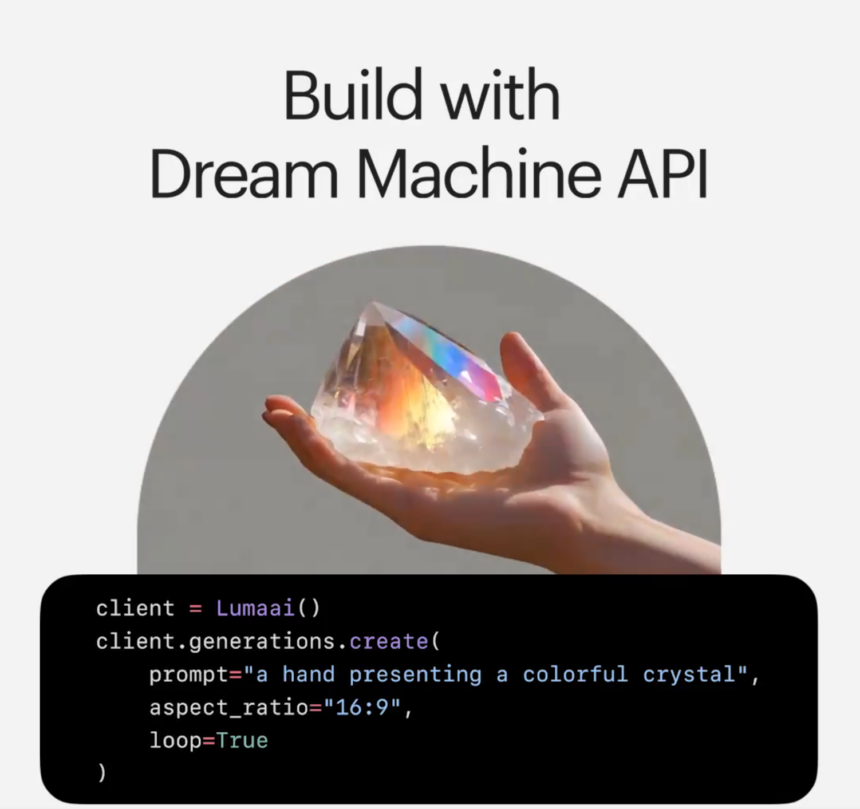On September 16, 2024, Luma AI launched its cutting-edge Dream Machine API, a tool that democratizes AI-powered video creation for freelancers, developers, and small to medium businesses (SMBs). With this API, users can generate dynamic and realistic videos from text or images without the complexities of traditional video production.
In this blog, I’ll explore the key features, use cases, pricing, and the SEO-friendly benefits that come with using the Dream Machine API.
What is the Dream Machine API?
The Dream Machine API is a video generation API designed to transform text descriptions or images into stunning videos. Built on an advanced transformer-based architecture, it processes multimodal inputs to deliver seamless, visually impressive outputs.
The API includes key capabilities like text-to-video generation, image-to-video conversion, camera control, video narrative creation, and loop creation. Whether you’re looking to produce social media content, marketing videos, or even interactive visuals for a website, this API offers a powerful and flexible solution.
Key Features of Dream Machine API
- Text-to-Video and Image-to-Video Conversion
- You can input text such as “a bird flying over a sunset beach” or upload an image. The API will convert these inputs into high-quality video sequences. This makes it ideal for those who need quick, visually appealing content.
- Camera Control in AI Video
- One standout feature is its ability to simulate cinematic camera movements. You can adjust the camera’s motion, direction, and angle within the video. This opens up new possibilities for creating dynamic content, such as action-packed scenes or narrative-driven videos.
- Video Narrative Creation
- Dream Machine allows users to extend existing videos or create looping visuals. This feature makes it perfect for projects like animated UI designs, tutorials, or video ads that need to loop seamlessly.
- Fast and Scalable
- Speed is a core feature of the Dream Machine API. It generates 120 frames in 120 seconds, making it one of the fastest AI video generation tools. This ensures a quick turnaround time, especially for creators working with deadlines.
Use Cases for Dream Machine API
Marketing and Advertising
Marketers can now generate eye-catching promotional videos in just minutes. The API’s ability to create dynamic content from text or images helps streamline marketing campaigns, making it easier to produce targeted video ads.
Social Media
For social media managers, loop creation and video extension features allow for engaging Instagram stories or TikTok videos. Whether you’re producing a trending story or an informative tutorial, you can use the API to automate video generation.
App and Web Development
Developers can seamlessly integrate the API with apps and websites using the available SDKs for Python and JavaScript. This is particularly useful for industries like e-learning, entertainment, and e-commerce. Apps that incorporate video generation directly into the user experience can offer more interactive and engaging content.
Pricing Structure
The Dream Machine API uses a flexible, pixel-based pricing model:
- The cost is $0.0032 per 1 million pixels generated, which amounts to about $0.35 for a 5-second video at 1280x720p resolution (24 fps).
This pricing structure is ideal for users of all sizes, allowing you to pay based on actual usage rather than committing to a fixed monthly fee.
How to Get Started
Getting started with the Dream Machine API is simple. You can sign up on the Luma AI website, get your API key, and start integrating it into your apps or workflows. The available documentation makes it easy to set up, and with support for both Python and JavaScript, developers of all skill levels can begin creating videos right away.
Dream Machine API is a game-changing tool for anyone looking to leverage AI video generation. With its ability to handle complex inputs like text and images, along with its camera control and video narrative features, it empowers creators to generate videos quickly, affordably, and without the need for professional editing skills.
Are you ready to take your video content to the next level? Visit Luma AI’s Dream Machine API and start exploring the future of AI-powered video generation.
Let us know how you plan to use the Dream Machine API for your next project in the comments below!
